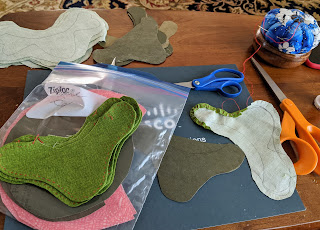People overestimate what they can do in a single day and
underestimate what they can do in their whole lives.
~unknown but possibly Bill Gates
Quilting
With the vines and leaves finally sewn, it's time to sew the flowers. There have been several iterations as you can see by the "cut and paste" of the template under this border. After recopying the entire swag once, I wore out and simply cut the old flower out and taped a new version in. Why? Because the petals extended too far and ended at the edges of the border fabric.
The flower base that covers the vine end was simplified, too. It's now a unique three lobed shape without specific leaf structures.
One tulip version had three separate petals that were too difficult to deal with. And I don't think they used less fabric than this simple bowl. It's definitely easier to sew this one that fits over the base easily. Since hand-quilting is not planned, the extra thickness shouldn't matter.
 |
| Lining up the tulip petals |
Then a teardrop petal was appliquéd on top. After looking at several placements, I matched the base of the teardrop with the base of the cup but the three petal points are lined up with the drawing underneath.
 |
| Pinning the final tulip petal |
Here are two of the vines extending from the center vase. The quiet speckled green print was a gift from my friend, Gayle. Thank you. There wouldn't have been enough leaves without that addition.
 |
| Vine and leaf detail |
And here's one side of the shorter border. Wow, that pink stands out.
 |
| Half of a vessel and vine border |
Do you see the rabbit in the vase print? I'm still considering re-applying the base of the vase. That curve is off a smidge.
QS gifted me some owl fabric at Christmas. Ever since college, my sisters notice and send any and all owls they encounter. This heavier linen blend made a simple, useful tote.
 |
| Tote with brown owl print and yellow |
Monthly FUR (Fabric Use Rate)
A kawandi placemat and the tote were finished in January. We are in the middle of home repairs so sewing slowed significantly. YTD = 2 yards.
Electric Socket Shock QAL
The first post is next week. Are you ready? I can't wait to see what everyone does with this basic block.
Did you see it? The Iowa Quilt Museum has a new exhibit, String Theory, about... {wait for it}... string quilts. How timely is that? Works from the ten quilters and collectors in the show include my friends Sujata Shah, Fern Royce, and Rod Kiracofe.
Curator Linzee McCray defines string quilts as "thin lengths of fabric sewn onto a foundation." They are usually considered utilitarian as evidenced by the random foundation papers on the backs of unfinished tops. The technique lends itself to "happy accidents and intricately planned designs alike."
The first Zoom meeting was last week and featured Rod with Siobahn Furguson discussing their quilts. More meetings are planned on Tuesdays at noon CST. You can sign up on the museum's website. {I'd link it here but it's not https. Doggone it. So look up their name.} They also plan a gallery walk online for $6 - the regular admission price. I can't wait and only wish I could attend in person!










